Developing Social Media Marketing for Shamiana Cuisines: Project
VerifiedAdded on 2023/01/03
|28
|9118
|75
Project
AI Summary
This professional research project, conducted by Manish Kumar Airy for a Graduate Diploma in Sales and Marketing, investigates the development of a social media marketing strategy to enhance customer retention and acquisition for Shamiana Cuisines of India. The study, supervised by Beverly Taylor, focuses on the restaurant's need to improve its marketing approach and leverage digital and social media strategies. Through a qualitative study involving interviews with restaurant managers and secondary research, the project identifies the importance of customer satisfaction, loyalty programs, feedback reviews, and continuous updates via social media to retain existing customers and attract new ones. The project includes an analysis of the restaurant's SWOT and PESTLE factors, theoretical reviews of customer retention, marketing strategies, and social media marketing, along with a detailed methodology, results, analysis, conclusions, recommendations, and an implementation plan. The project underscores the critical role of social media in today's competitive market and suggests actionable strategies for Shamiana Cuisines to improve its marketing performance and overall success.
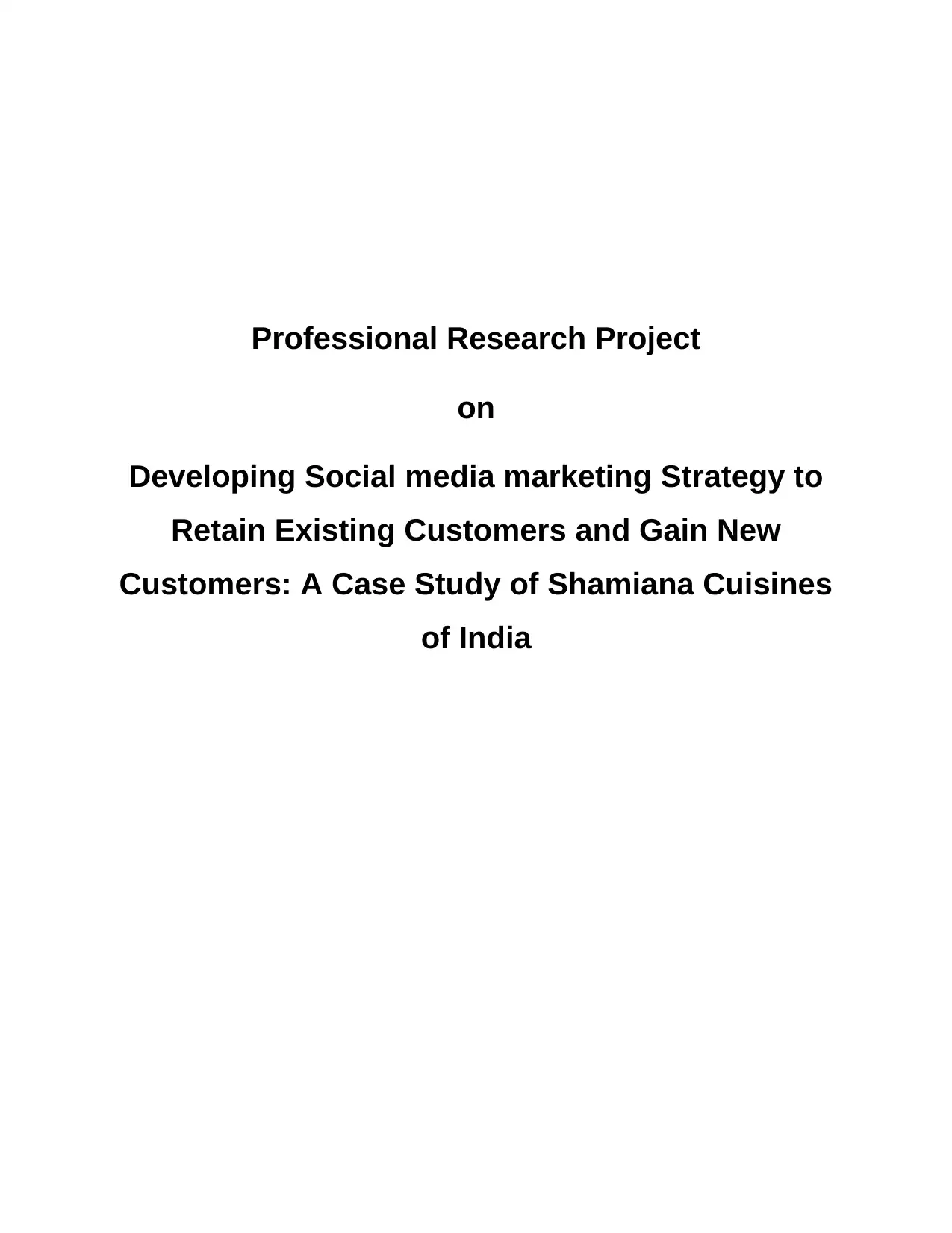
Professional Research Project
on
Developing Social media marketing Strategy to
Retain Existing Customers and Gain New
Customers: A Case Study of Shamiana Cuisines
of India
on
Developing Social media marketing Strategy to
Retain Existing Customers and Gain New
Customers: A Case Study of Shamiana Cuisines
of India
Paraphrase This Document
Need a fresh take? Get an instant paraphrase of this document with our AI Paraphraser
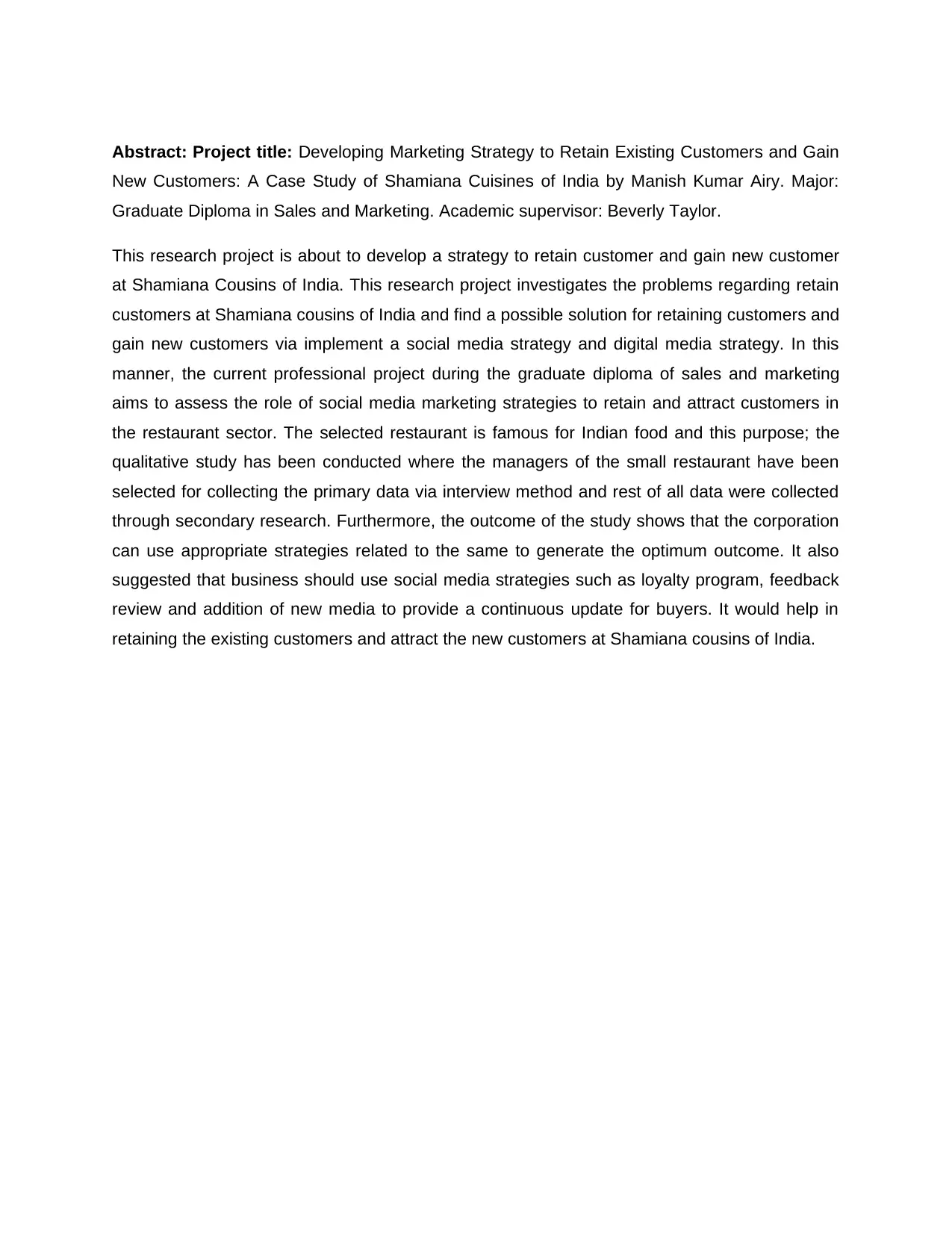
Abstract: Project title: Developing Marketing Strategy to Retain Existing Customers and Gain
New Customers: A Case Study of Shamiana Cuisines of India by Manish Kumar Airy. Major:
Graduate Diploma in Sales and Marketing. Academic supervisor: Beverly Taylor.
This research project is about to develop a strategy to retain customer and gain new customer
at Shamiana Cousins of India. This research project investigates the problems regarding retain
customers at Shamiana cousins of India and find a possible solution for retaining customers and
gain new customers via implement a social media strategy and digital media strategy. In this
manner, the current professional project during the graduate diploma of sales and marketing
aims to assess the role of social media marketing strategies to retain and attract customers in
the restaurant sector. The selected restaurant is famous for Indian food and this purpose; the
qualitative study has been conducted where the managers of the small restaurant have been
selected for collecting the primary data via interview method and rest of all data were collected
through secondary research. Furthermore, the outcome of the study shows that the corporation
can use appropriate strategies related to the same to generate the optimum outcome. It also
suggested that business should use social media strategies such as loyalty program, feedback
review and addition of new media to provide a continuous update for buyers. It would help in
retaining the existing customers and attract the new customers at Shamiana cousins of India.
New Customers: A Case Study of Shamiana Cuisines of India by Manish Kumar Airy. Major:
Graduate Diploma in Sales and Marketing. Academic supervisor: Beverly Taylor.
This research project is about to develop a strategy to retain customer and gain new customer
at Shamiana Cousins of India. This research project investigates the problems regarding retain
customers at Shamiana cousins of India and find a possible solution for retaining customers and
gain new customers via implement a social media strategy and digital media strategy. In this
manner, the current professional project during the graduate diploma of sales and marketing
aims to assess the role of social media marketing strategies to retain and attract customers in
the restaurant sector. The selected restaurant is famous for Indian food and this purpose; the
qualitative study has been conducted where the managers of the small restaurant have been
selected for collecting the primary data via interview method and rest of all data were collected
through secondary research. Furthermore, the outcome of the study shows that the corporation
can use appropriate strategies related to the same to generate the optimum outcome. It also
suggested that business should use social media strategies such as loyalty program, feedback
review and addition of new media to provide a continuous update for buyers. It would help in
retaining the existing customers and attract the new customers at Shamiana cousins of India.
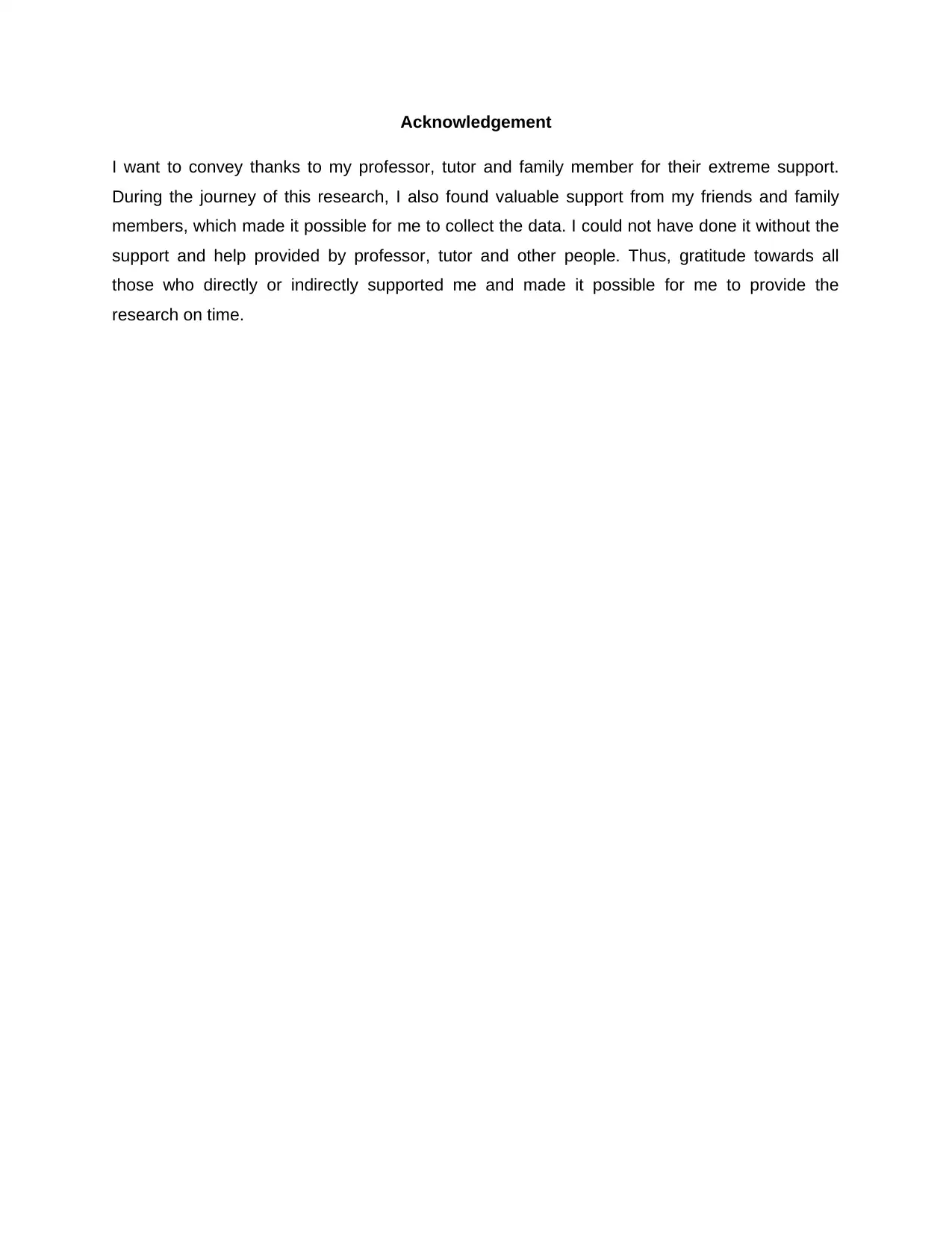
Acknowledgement
I want to convey thanks to my professor, tutor and family member for their extreme support.
During the journey of this research, I also found valuable support from my friends and family
members, which made it possible for me to collect the data. I could not have done it without the
support and help provided by professor, tutor and other people. Thus, gratitude towards all
those who directly or indirectly supported me and made it possible for me to provide the
research on time.
I want to convey thanks to my professor, tutor and family member for their extreme support.
During the journey of this research, I also found valuable support from my friends and family
members, which made it possible for me to collect the data. I could not have done it without the
support and help provided by professor, tutor and other people. Thus, gratitude towards all
those who directly or indirectly supported me and made it possible for me to provide the
research on time.
⊘ This is a preview!⊘
Do you want full access?
Subscribe today to unlock all pages.

Trusted by 1+ million students worldwide
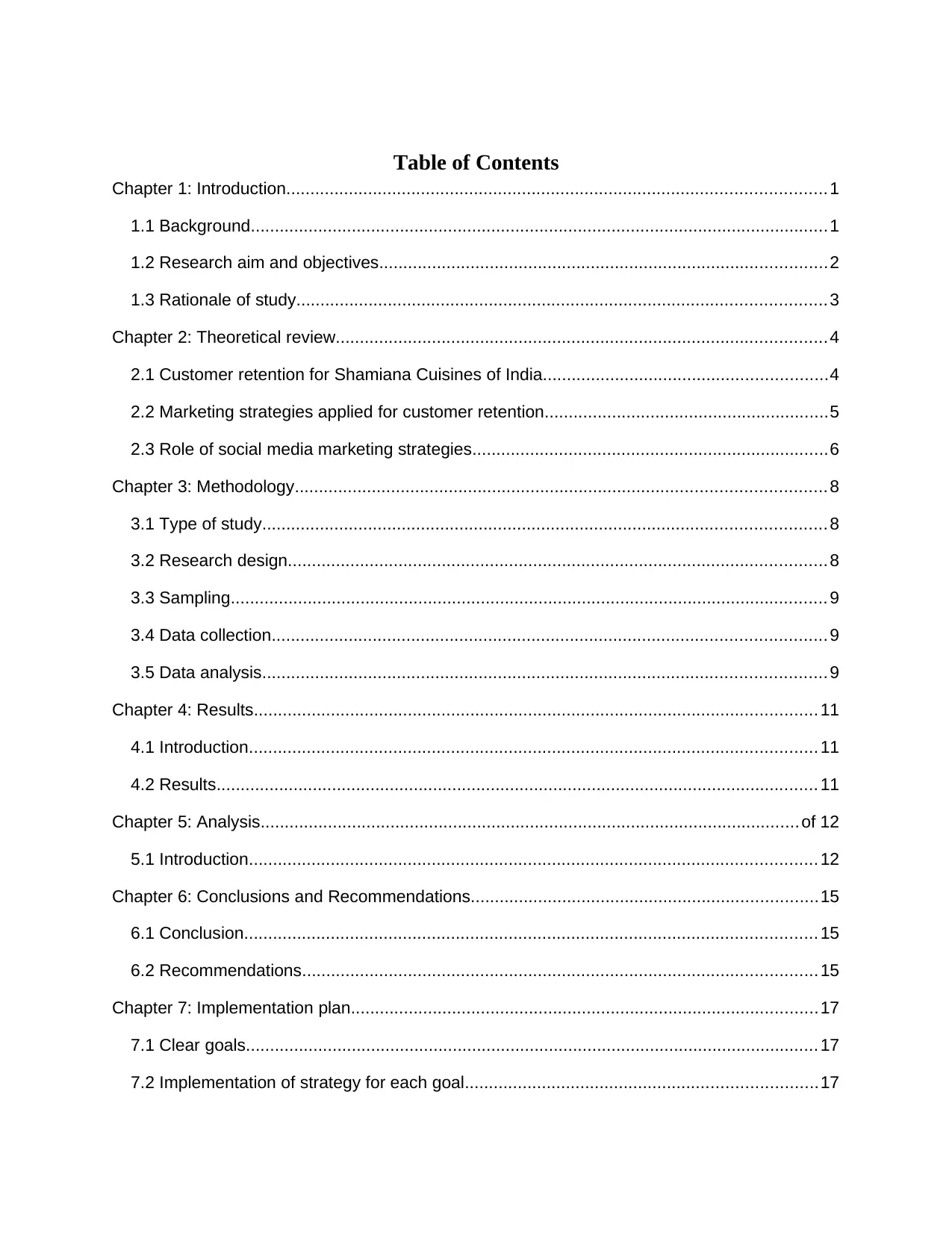
Table of Contents
Chapter 1: Introduction................................................................................................................ 1
1.1 Background........................................................................................................................ 1
1.2 Research aim and objectives.............................................................................................2
1.3 Rationale of study.............................................................................................................. 3
Chapter 2: Theoretical review......................................................................................................4
2.1 Customer retention for Shamiana Cuisines of India...........................................................4
2.2 Marketing strategies applied for customer retention...........................................................5
2.3 Role of social media marketing strategies..........................................................................6
Chapter 3: Methodology.............................................................................................................. 8
3.1 Type of study..................................................................................................................... 8
3.2 Research design................................................................................................................ 8
3.3 Sampling............................................................................................................................ 9
3.4 Data collection................................................................................................................... 9
3.5 Data analysis..................................................................................................................... 9
Chapter 4: Results..................................................................................................................... 11
4.1 Introduction...................................................................................................................... 11
4.2 Results............................................................................................................................. 11
Chapter 5: Analysis................................................................................................................ of 12
5.1 Introduction...................................................................................................................... 12
Chapter 6: Conclusions and Recommendations........................................................................15
6.1 Conclusion....................................................................................................................... 15
6.2 Recommendations...........................................................................................................15
Chapter 7: Implementation plan.................................................................................................17
7.1 Clear goals....................................................................................................................... 17
7.2 Implementation of strategy for each goal.........................................................................17
Chapter 1: Introduction................................................................................................................ 1
1.1 Background........................................................................................................................ 1
1.2 Research aim and objectives.............................................................................................2
1.3 Rationale of study.............................................................................................................. 3
Chapter 2: Theoretical review......................................................................................................4
2.1 Customer retention for Shamiana Cuisines of India...........................................................4
2.2 Marketing strategies applied for customer retention...........................................................5
2.3 Role of social media marketing strategies..........................................................................6
Chapter 3: Methodology.............................................................................................................. 8
3.1 Type of study..................................................................................................................... 8
3.2 Research design................................................................................................................ 8
3.3 Sampling............................................................................................................................ 9
3.4 Data collection................................................................................................................... 9
3.5 Data analysis..................................................................................................................... 9
Chapter 4: Results..................................................................................................................... 11
4.1 Introduction...................................................................................................................... 11
4.2 Results............................................................................................................................. 11
Chapter 5: Analysis................................................................................................................ of 12
5.1 Introduction...................................................................................................................... 12
Chapter 6: Conclusions and Recommendations........................................................................15
6.1 Conclusion....................................................................................................................... 15
6.2 Recommendations...........................................................................................................15
Chapter 7: Implementation plan.................................................................................................17
7.1 Clear goals....................................................................................................................... 17
7.2 Implementation of strategy for each goal.........................................................................17
Paraphrase This Document
Need a fresh take? Get an instant paraphrase of this document with our AI Paraphraser
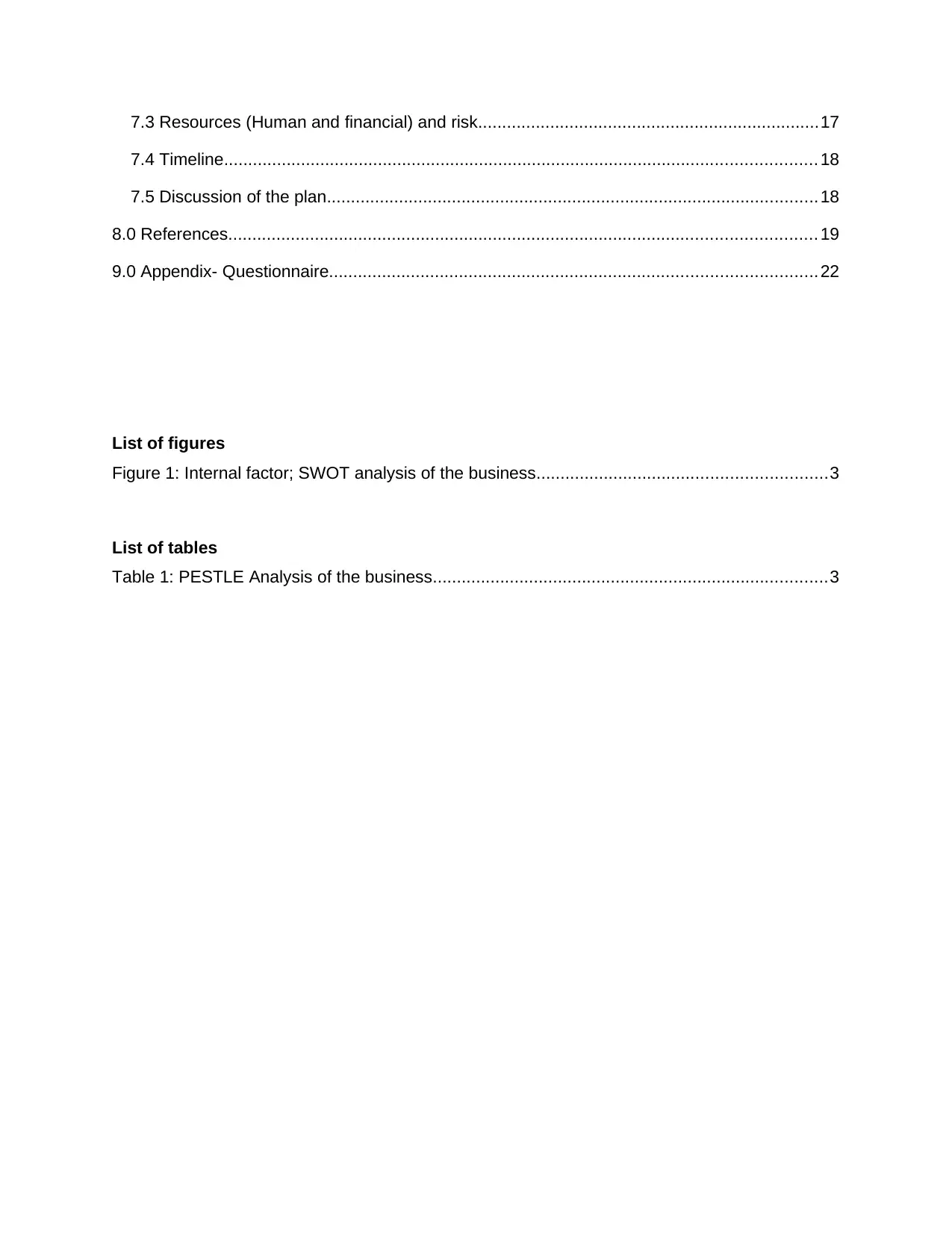
7.3 Resources (Human and financial) and risk.......................................................................17
7.4 Timeline........................................................................................................................... 18
7.5 Discussion of the plan......................................................................................................18
8.0 References.......................................................................................................................... 19
9.0 Appendix- Questionnaire.....................................................................................................22
List of figures
Figure 1: Internal factor; SWOT analysis of the business............................................................3
List of tables
Table 1: PESTLE Analysis of the business..................................................................................3
7.4 Timeline........................................................................................................................... 18
7.5 Discussion of the plan......................................................................................................18
8.0 References.......................................................................................................................... 19
9.0 Appendix- Questionnaire.....................................................................................................22
List of figures
Figure 1: Internal factor; SWOT analysis of the business............................................................3
List of tables
Table 1: PESTLE Analysis of the business..................................................................................3
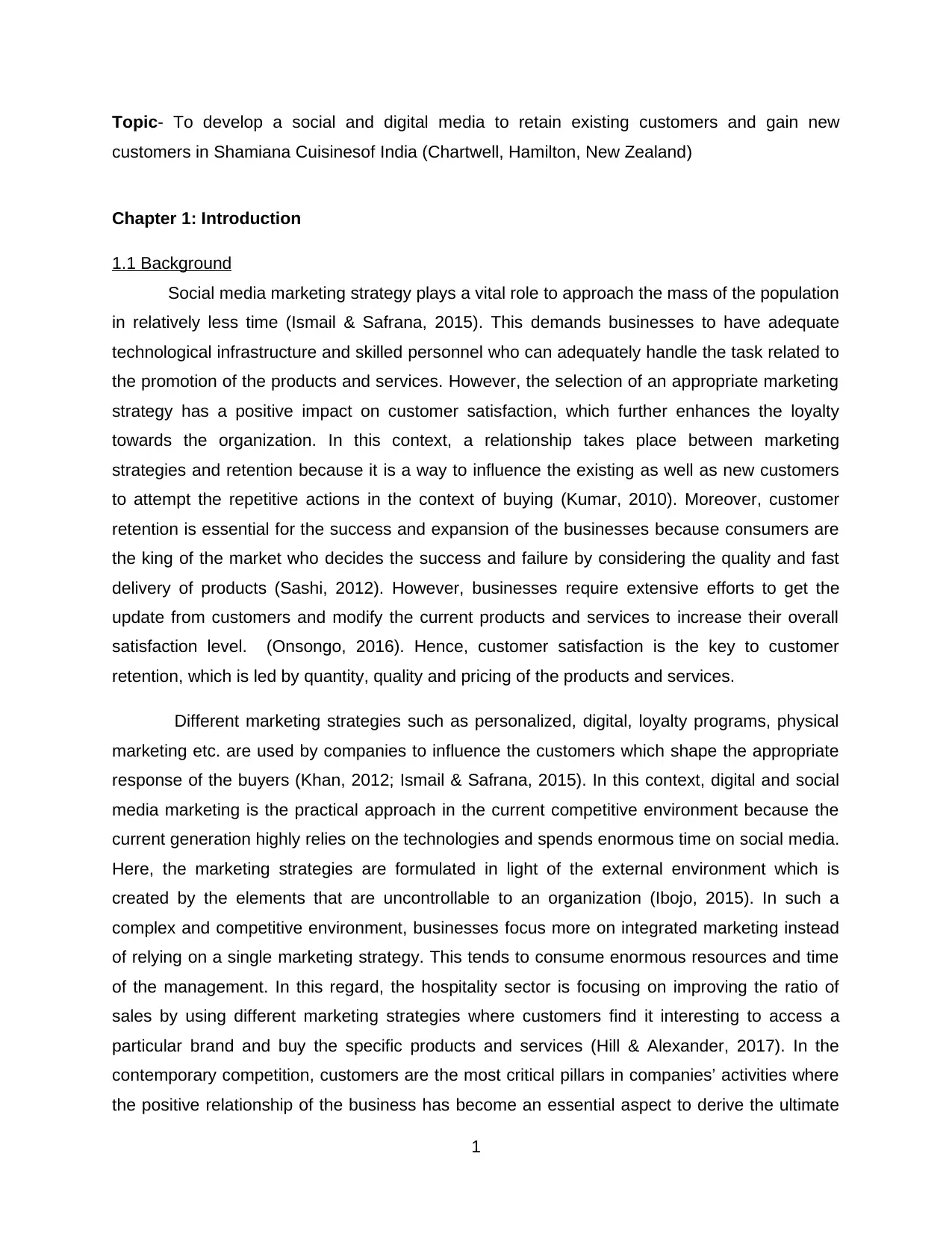
Topic- To develop a social and digital media to retain existing customers and gain new
customers in Shamiana Cuisinesof India (Chartwell, Hamilton, New Zealand)
Chapter 1: Introduction
1.1 Background
Social media marketing strategy plays a vital role to approach the mass of the population
in relatively less time (Ismail & Safrana, 2015). This demands businesses to have adequate
technological infrastructure and skilled personnel who can adequately handle the task related to
the promotion of the products and services. However, the selection of an appropriate marketing
strategy has a positive impact on customer satisfaction, which further enhances the loyalty
towards the organization. In this context, a relationship takes place between marketing
strategies and retention because it is a way to influence the existing as well as new customers
to attempt the repetitive actions in the context of buying (Kumar, 2010). Moreover, customer
retention is essential for the success and expansion of the businesses because consumers are
the king of the market who decides the success and failure by considering the quality and fast
delivery of products (Sashi, 2012). However, businesses require extensive efforts to get the
update from customers and modify the current products and services to increase their overall
satisfaction level. (Onsongo, 2016). Hence, customer satisfaction is the key to customer
retention, which is led by quantity, quality and pricing of the products and services.
Different marketing strategies such as personalized, digital, loyalty programs, physical
marketing etc. are used by companies to influence the customers which shape the appropriate
response of the buyers (Khan, 2012; Ismail & Safrana, 2015). In this context, digital and social
media marketing is the practical approach in the current competitive environment because the
current generation highly relies on the technologies and spends enormous time on social media.
Here, the marketing strategies are formulated in light of the external environment which is
created by the elements that are uncontrollable to an organization (Ibojo, 2015). In such a
complex and competitive environment, businesses focus more on integrated marketing instead
of relying on a single marketing strategy. This tends to consume enormous resources and time
of the management. In this regard, the hospitality sector is focusing on improving the ratio of
sales by using different marketing strategies where customers find it interesting to access a
particular brand and buy the specific products and services (Hill & Alexander, 2017). In the
contemporary competition, customers are the most critical pillars in companies’ activities where
the positive relationship of the business has become an essential aspect to derive the ultimate
1
customers in Shamiana Cuisinesof India (Chartwell, Hamilton, New Zealand)
Chapter 1: Introduction
1.1 Background
Social media marketing strategy plays a vital role to approach the mass of the population
in relatively less time (Ismail & Safrana, 2015). This demands businesses to have adequate
technological infrastructure and skilled personnel who can adequately handle the task related to
the promotion of the products and services. However, the selection of an appropriate marketing
strategy has a positive impact on customer satisfaction, which further enhances the loyalty
towards the organization. In this context, a relationship takes place between marketing
strategies and retention because it is a way to influence the existing as well as new customers
to attempt the repetitive actions in the context of buying (Kumar, 2010). Moreover, customer
retention is essential for the success and expansion of the businesses because consumers are
the king of the market who decides the success and failure by considering the quality and fast
delivery of products (Sashi, 2012). However, businesses require extensive efforts to get the
update from customers and modify the current products and services to increase their overall
satisfaction level. (Onsongo, 2016). Hence, customer satisfaction is the key to customer
retention, which is led by quantity, quality and pricing of the products and services.
Different marketing strategies such as personalized, digital, loyalty programs, physical
marketing etc. are used by companies to influence the customers which shape the appropriate
response of the buyers (Khan, 2012; Ismail & Safrana, 2015). In this context, digital and social
media marketing is the practical approach in the current competitive environment because the
current generation highly relies on the technologies and spends enormous time on social media.
Here, the marketing strategies are formulated in light of the external environment which is
created by the elements that are uncontrollable to an organization (Ibojo, 2015). In such a
complex and competitive environment, businesses focus more on integrated marketing instead
of relying on a single marketing strategy. This tends to consume enormous resources and time
of the management. In this regard, the hospitality sector is focusing on improving the ratio of
sales by using different marketing strategies where customers find it interesting to access a
particular brand and buy the specific products and services (Hill & Alexander, 2017). In the
contemporary competition, customers are the most critical pillars in companies’ activities where
the positive relationship of the business has become an essential aspect to derive the ultimate
1
⊘ This is a preview!⊘
Do you want full access?
Subscribe today to unlock all pages.

Trusted by 1+ million students worldwide
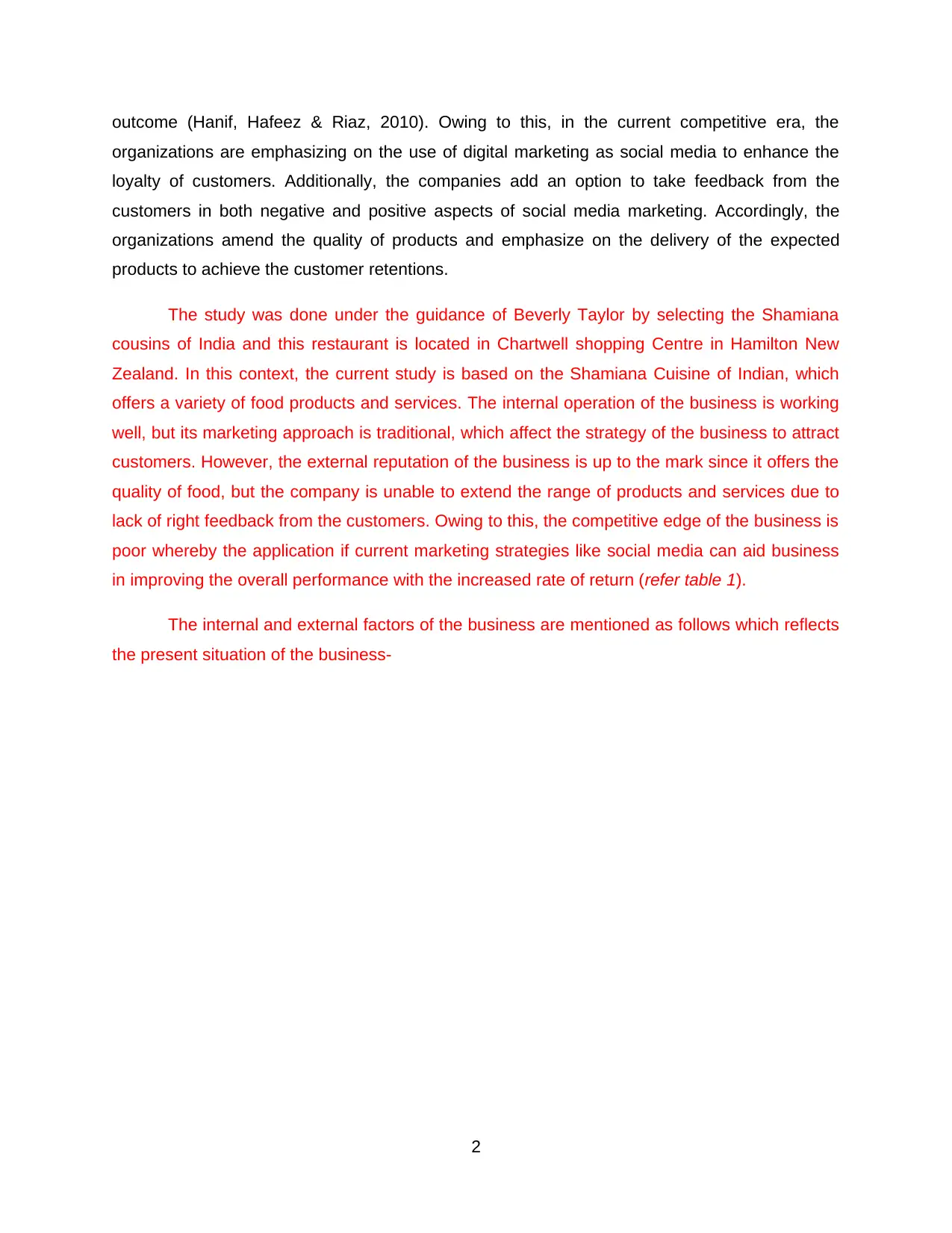
outcome (Hanif, Hafeez & Riaz, 2010). Owing to this, in the current competitive era, the
organizations are emphasizing on the use of digital marketing as social media to enhance the
loyalty of customers. Additionally, the companies add an option to take feedback from the
customers in both negative and positive aspects of social media marketing. Accordingly, the
organizations amend the quality of products and emphasize on the delivery of the expected
products to achieve the customer retentions.
The study was done under the guidance of Beverly Taylor by selecting the Shamiana
cousins of India and this restaurant is located in Chartwell shopping Centre in Hamilton New
Zealand. In this context, the current study is based on the Shamiana Cuisine of Indian, which
offers a variety of food products and services. The internal operation of the business is working
well, but its marketing approach is traditional, which affect the strategy of the business to attract
customers. However, the external reputation of the business is up to the mark since it offers the
quality of food, but the company is unable to extend the range of products and services due to
lack of right feedback from the customers. Owing to this, the competitive edge of the business is
poor whereby the application if current marketing strategies like social media can aid business
in improving the overall performance with the increased rate of return (refer table 1).
The internal and external factors of the business are mentioned as follows which reflects
the present situation of the business-
2
organizations are emphasizing on the use of digital marketing as social media to enhance the
loyalty of customers. Additionally, the companies add an option to take feedback from the
customers in both negative and positive aspects of social media marketing. Accordingly, the
organizations amend the quality of products and emphasize on the delivery of the expected
products to achieve the customer retentions.
The study was done under the guidance of Beverly Taylor by selecting the Shamiana
cousins of India and this restaurant is located in Chartwell shopping Centre in Hamilton New
Zealand. In this context, the current study is based on the Shamiana Cuisine of Indian, which
offers a variety of food products and services. The internal operation of the business is working
well, but its marketing approach is traditional, which affect the strategy of the business to attract
customers. However, the external reputation of the business is up to the mark since it offers the
quality of food, but the company is unable to extend the range of products and services due to
lack of right feedback from the customers. Owing to this, the competitive edge of the business is
poor whereby the application if current marketing strategies like social media can aid business
in improving the overall performance with the increased rate of return (refer table 1).
The internal and external factors of the business are mentioned as follows which reflects
the present situation of the business-
2
Paraphrase This Document
Need a fresh take? Get an instant paraphrase of this document with our AI Paraphraser
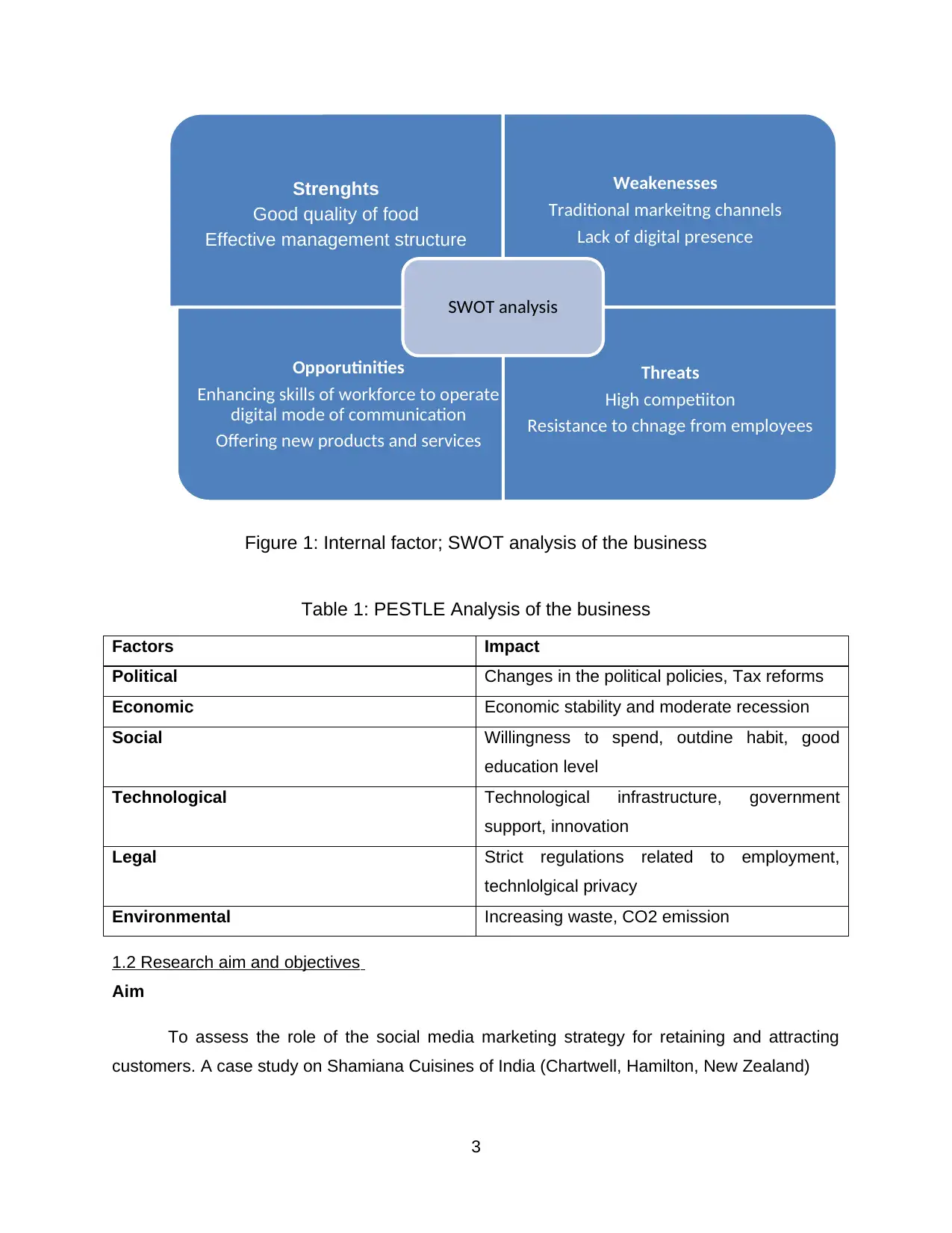
Figure 1: Internal factor; SWOT analysis of the business
Table 1: PESTLE Analysis of the business
Factors Impact
Political Changes in the political policies, Tax reforms
Economic Economic stability and moderate recession
Social Willingness to spend, outdine habit, good
education level
Technological Technological infrastructure, government
support, innovation
Legal Strict regulations related to employment,
technlolgical privacy
Environmental Increasing waste, CO2 emission
1.2 Research aim and objectives
Aim
To assess the role of the social media marketing strategy for retaining and attracting
customers. A case study on Shamiana Cuisines of India (Chartwell, Hamilton, New Zealand)
3
Strenghts
Good quality of food
Effective management structure
Weakenesses
Traditional markeitng channels
Lack of digital presence
Opporutinities
Enhancing skills of workforce to operate
digital mode of communication
Offering new products and services
Threats
High competiiton
Resistance to chnage from employees
SWOT analysis
Table 1: PESTLE Analysis of the business
Factors Impact
Political Changes in the political policies, Tax reforms
Economic Economic stability and moderate recession
Social Willingness to spend, outdine habit, good
education level
Technological Technological infrastructure, government
support, innovation
Legal Strict regulations related to employment,
technlolgical privacy
Environmental Increasing waste, CO2 emission
1.2 Research aim and objectives
Aim
To assess the role of the social media marketing strategy for retaining and attracting
customers. A case study on Shamiana Cuisines of India (Chartwell, Hamilton, New Zealand)
3
Strenghts
Good quality of food
Effective management structure
Weakenesses
Traditional markeitng channels
Lack of digital presence
Opporutinities
Enhancing skills of workforce to operate
digital mode of communication
Offering new products and services
Threats
High competiiton
Resistance to chnage from employees
SWOT analysis
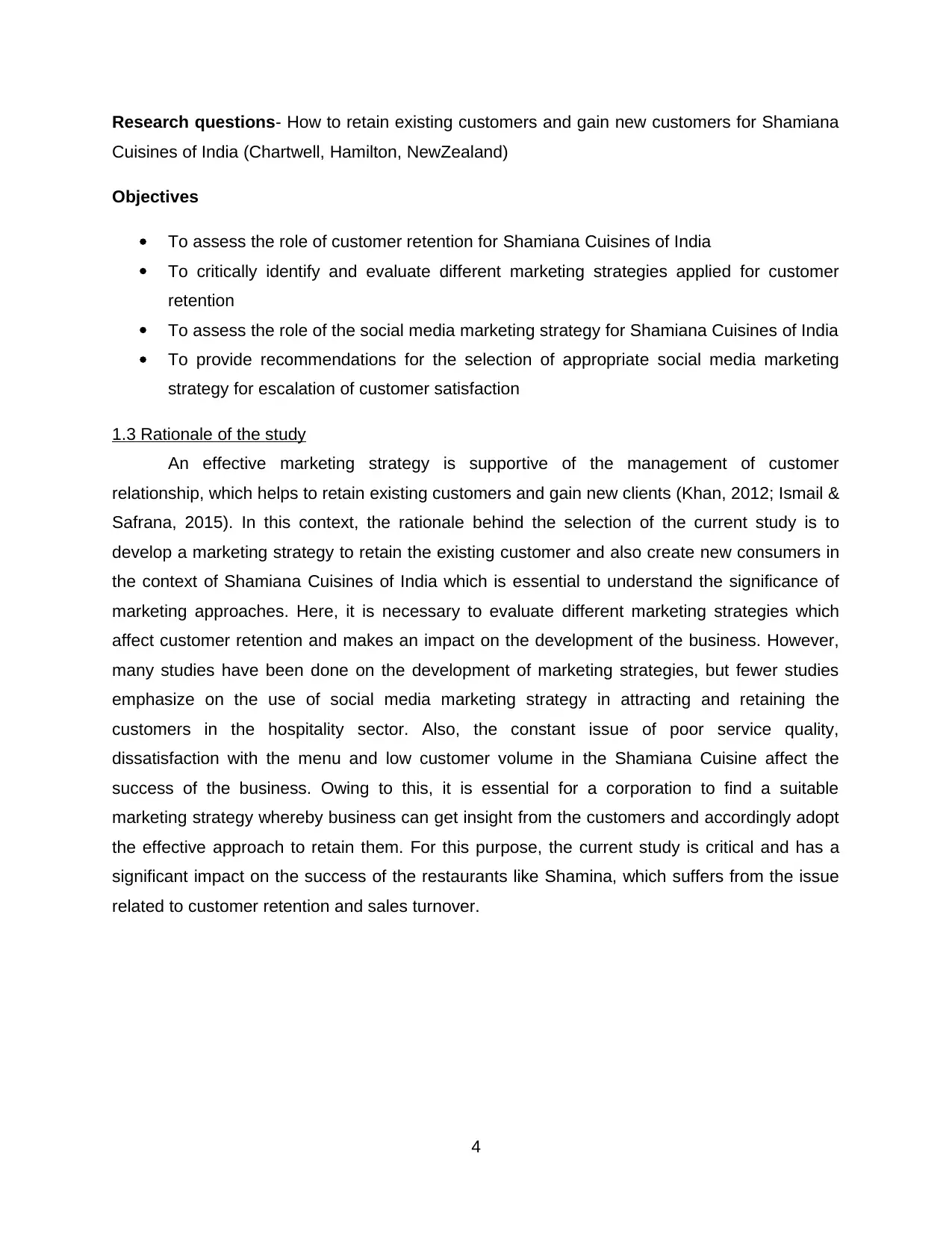
Research questions- How to retain existing customers and gain new customers for Shamiana
Cuisines of India (Chartwell, Hamilton, NewZealand)
Objectives
To assess the role of customer retention for Shamiana Cuisines of India
To critically identify and evaluate different marketing strategies applied for customer
retention
To assess the role of the social media marketing strategy for Shamiana Cuisines of India
To provide recommendations for the selection of appropriate social media marketing
strategy for escalation of customer satisfaction
1.3 Rationale of the study
An effective marketing strategy is supportive of the management of customer
relationship, which helps to retain existing customers and gain new clients (Khan, 2012; Ismail &
Safrana, 2015). In this context, the rationale behind the selection of the current study is to
develop a marketing strategy to retain the existing customer and also create new consumers in
the context of Shamiana Cuisines of India which is essential to understand the significance of
marketing approaches. Here, it is necessary to evaluate different marketing strategies which
affect customer retention and makes an impact on the development of the business. However,
many studies have been done on the development of marketing strategies, but fewer studies
emphasize on the use of social media marketing strategy in attracting and retaining the
customers in the hospitality sector. Also, the constant issue of poor service quality,
dissatisfaction with the menu and low customer volume in the Shamiana Cuisine affect the
success of the business. Owing to this, it is essential for a corporation to find a suitable
marketing strategy whereby business can get insight from the customers and accordingly adopt
the effective approach to retain them. For this purpose, the current study is critical and has a
significant impact on the success of the restaurants like Shamina, which suffers from the issue
related to customer retention and sales turnover.
4
Cuisines of India (Chartwell, Hamilton, NewZealand)
Objectives
To assess the role of customer retention for Shamiana Cuisines of India
To critically identify and evaluate different marketing strategies applied for customer
retention
To assess the role of the social media marketing strategy for Shamiana Cuisines of India
To provide recommendations for the selection of appropriate social media marketing
strategy for escalation of customer satisfaction
1.3 Rationale of the study
An effective marketing strategy is supportive of the management of customer
relationship, which helps to retain existing customers and gain new clients (Khan, 2012; Ismail &
Safrana, 2015). In this context, the rationale behind the selection of the current study is to
develop a marketing strategy to retain the existing customer and also create new consumers in
the context of Shamiana Cuisines of India which is essential to understand the significance of
marketing approaches. Here, it is necessary to evaluate different marketing strategies which
affect customer retention and makes an impact on the development of the business. However,
many studies have been done on the development of marketing strategies, but fewer studies
emphasize on the use of social media marketing strategy in attracting and retaining the
customers in the hospitality sector. Also, the constant issue of poor service quality,
dissatisfaction with the menu and low customer volume in the Shamiana Cuisine affect the
success of the business. Owing to this, it is essential for a corporation to find a suitable
marketing strategy whereby business can get insight from the customers and accordingly adopt
the effective approach to retain them. For this purpose, the current study is critical and has a
significant impact on the success of the restaurants like Shamina, which suffers from the issue
related to customer retention and sales turnover.
4
⊘ This is a preview!⊘
Do you want full access?
Subscribe today to unlock all pages.

Trusted by 1+ million students worldwide
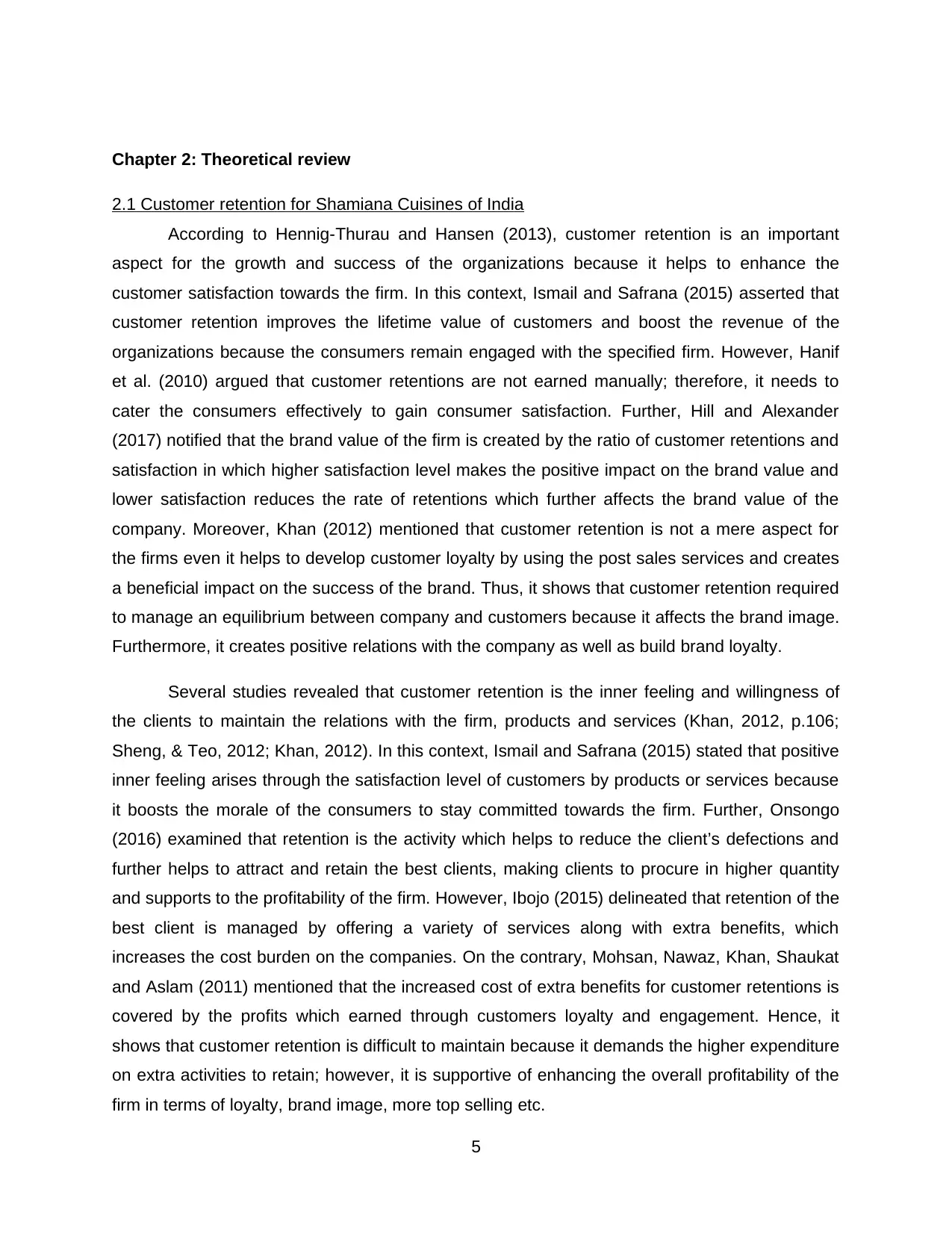
Chapter 2: Theoretical review
2.1 Customer retention for Shamiana Cuisines of India
According to Hennig-Thurau and Hansen (2013), customer retention is an important
aspect for the growth and success of the organizations because it helps to enhance the
customer satisfaction towards the firm. In this context, Ismail and Safrana (2015) asserted that
customer retention improves the lifetime value of customers and boost the revenue of the
organizations because the consumers remain engaged with the specified firm. However, Hanif
et al. (2010) argued that customer retentions are not earned manually; therefore, it needs to
cater the consumers effectively to gain consumer satisfaction. Further, Hill and Alexander
(2017) notified that the brand value of the firm is created by the ratio of customer retentions and
satisfaction in which higher satisfaction level makes the positive impact on the brand value and
lower satisfaction reduces the rate of retentions which further affects the brand value of the
company. Moreover, Khan (2012) mentioned that customer retention is not a mere aspect for
the firms even it helps to develop customer loyalty by using the post sales services and creates
a beneficial impact on the success of the brand. Thus, it shows that customer retention required
to manage an equilibrium between company and customers because it affects the brand image.
Furthermore, it creates positive relations with the company as well as build brand loyalty.
Several studies revealed that customer retention is the inner feeling and willingness of
the clients to maintain the relations with the firm, products and services (Khan, 2012, p.106;
Sheng, & Teo, 2012; Khan, 2012). In this context, Ismail and Safrana (2015) stated that positive
inner feeling arises through the satisfaction level of customers by products or services because
it boosts the morale of the consumers to stay committed towards the firm. Further, Onsongo
(2016) examined that retention is the activity which helps to reduce the client’s defections and
further helps to attract and retain the best clients, making clients to procure in higher quantity
and supports to the profitability of the firm. However, Ibojo (2015) delineated that retention of the
best client is managed by offering a variety of services along with extra benefits, which
increases the cost burden on the companies. On the contrary, Mohsan, Nawaz, Khan, Shaukat
and Aslam (2011) mentioned that the increased cost of extra benefits for customer retentions is
covered by the profits which earned through customers loyalty and engagement. Hence, it
shows that customer retention is difficult to maintain because it demands the higher expenditure
on extra activities to retain; however, it is supportive of enhancing the overall profitability of the
firm in terms of loyalty, brand image, more top selling etc.
5
2.1 Customer retention for Shamiana Cuisines of India
According to Hennig-Thurau and Hansen (2013), customer retention is an important
aspect for the growth and success of the organizations because it helps to enhance the
customer satisfaction towards the firm. In this context, Ismail and Safrana (2015) asserted that
customer retention improves the lifetime value of customers and boost the revenue of the
organizations because the consumers remain engaged with the specified firm. However, Hanif
et al. (2010) argued that customer retentions are not earned manually; therefore, it needs to
cater the consumers effectively to gain consumer satisfaction. Further, Hill and Alexander
(2017) notified that the brand value of the firm is created by the ratio of customer retentions and
satisfaction in which higher satisfaction level makes the positive impact on the brand value and
lower satisfaction reduces the rate of retentions which further affects the brand value of the
company. Moreover, Khan (2012) mentioned that customer retention is not a mere aspect for
the firms even it helps to develop customer loyalty by using the post sales services and creates
a beneficial impact on the success of the brand. Thus, it shows that customer retention required
to manage an equilibrium between company and customers because it affects the brand image.
Furthermore, it creates positive relations with the company as well as build brand loyalty.
Several studies revealed that customer retention is the inner feeling and willingness of
the clients to maintain the relations with the firm, products and services (Khan, 2012, p.106;
Sheng, & Teo, 2012; Khan, 2012). In this context, Ismail and Safrana (2015) stated that positive
inner feeling arises through the satisfaction level of customers by products or services because
it boosts the morale of the consumers to stay committed towards the firm. Further, Onsongo
(2016) examined that retention is the activity which helps to reduce the client’s defections and
further helps to attract and retain the best clients, making clients to procure in higher quantity
and supports to the profitability of the firm. However, Ibojo (2015) delineated that retention of the
best client is managed by offering a variety of services along with extra benefits, which
increases the cost burden on the companies. On the contrary, Mohsan, Nawaz, Khan, Shaukat
and Aslam (2011) mentioned that the increased cost of extra benefits for customer retentions is
covered by the profits which earned through customers loyalty and engagement. Hence, it
shows that customer retention is difficult to maintain because it demands the higher expenditure
on extra activities to retain; however, it is supportive of enhancing the overall profitability of the
firm in terms of loyalty, brand image, more top selling etc.
5
Paraphrase This Document
Need a fresh take? Get an instant paraphrase of this document with our AI Paraphraser
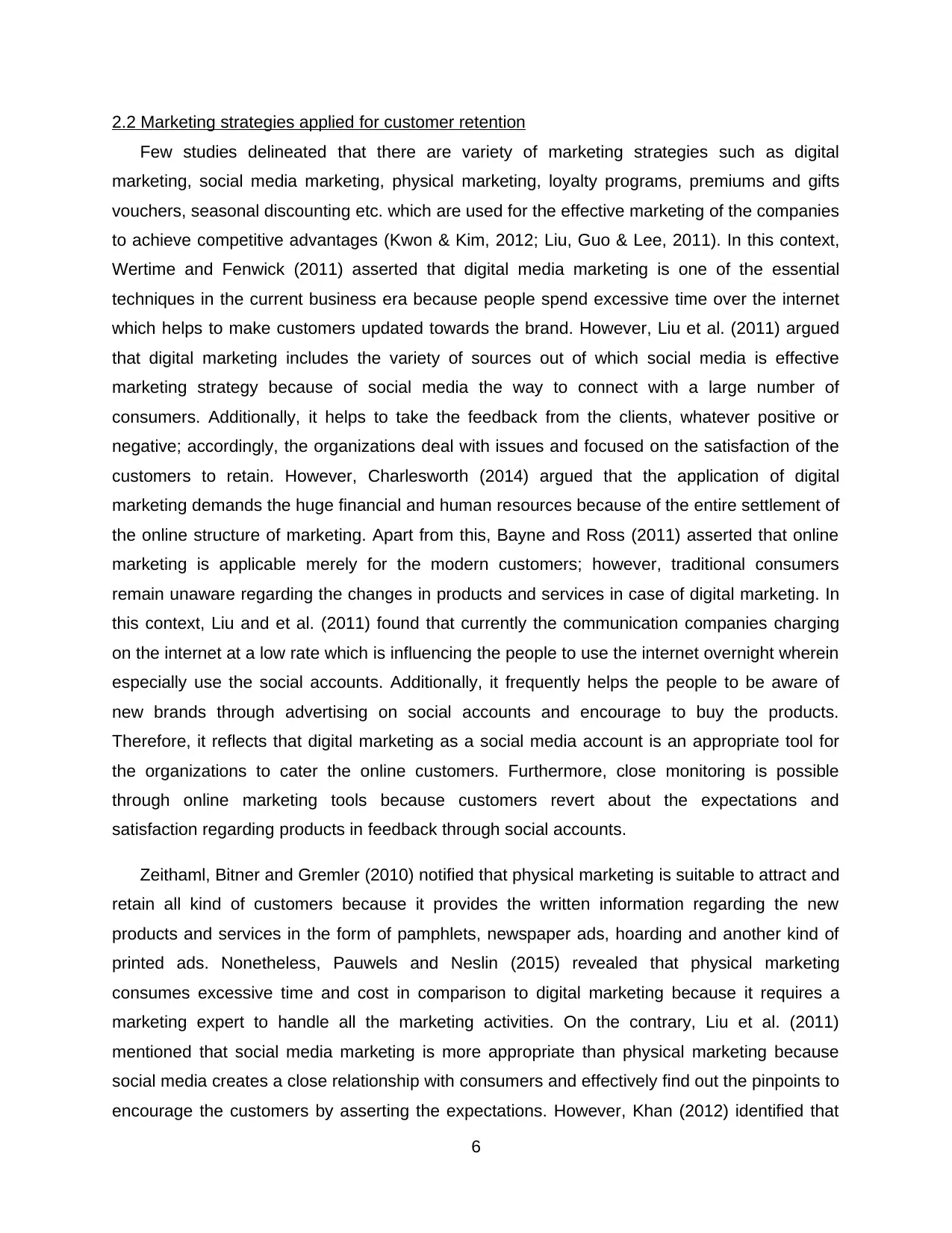
2.2 Marketing strategies applied for customer retention
Few studies delineated that there are variety of marketing strategies such as digital
marketing, social media marketing, physical marketing, loyalty programs, premiums and gifts
vouchers, seasonal discounting etc. which are used for the effective marketing of the companies
to achieve competitive advantages (Kwon & Kim, 2012; Liu, Guo & Lee, 2011). In this context,
Wertime and Fenwick (2011) asserted that digital media marketing is one of the essential
techniques in the current business era because people spend excessive time over the internet
which helps to make customers updated towards the brand. However, Liu et al. (2011) argued
that digital marketing includes the variety of sources out of which social media is effective
marketing strategy because of social media the way to connect with a large number of
consumers. Additionally, it helps to take the feedback from the clients, whatever positive or
negative; accordingly, the organizations deal with issues and focused on the satisfaction of the
customers to retain. However, Charlesworth (2014) argued that the application of digital
marketing demands the huge financial and human resources because of the entire settlement of
the online structure of marketing. Apart from this, Bayne and Ross (2011) asserted that online
marketing is applicable merely for the modern customers; however, traditional consumers
remain unaware regarding the changes in products and services in case of digital marketing. In
this context, Liu and et al. (2011) found that currently the communication companies charging
on the internet at a low rate which is influencing the people to use the internet overnight wherein
especially use the social accounts. Additionally, it frequently helps the people to be aware of
new brands through advertising on social accounts and encourage to buy the products.
Therefore, it reflects that digital marketing as a social media account is an appropriate tool for
the organizations to cater the online customers. Furthermore, close monitoring is possible
through online marketing tools because customers revert about the expectations and
satisfaction regarding products in feedback through social accounts.
Zeithaml, Bitner and Gremler (2010) notified that physical marketing is suitable to attract and
retain all kind of customers because it provides the written information regarding the new
products and services in the form of pamphlets, newspaper ads, hoarding and another kind of
printed ads. Nonetheless, Pauwels and Neslin (2015) revealed that physical marketing
consumes excessive time and cost in comparison to digital marketing because it requires a
marketing expert to handle all the marketing activities. On the contrary, Liu et al. (2011)
mentioned that social media marketing is more appropriate than physical marketing because
social media creates a close relationship with consumers and effectively find out the pinpoints to
encourage the customers by asserting the expectations. However, Khan (2012) identified that
6
Few studies delineated that there are variety of marketing strategies such as digital
marketing, social media marketing, physical marketing, loyalty programs, premiums and gifts
vouchers, seasonal discounting etc. which are used for the effective marketing of the companies
to achieve competitive advantages (Kwon & Kim, 2012; Liu, Guo & Lee, 2011). In this context,
Wertime and Fenwick (2011) asserted that digital media marketing is one of the essential
techniques in the current business era because people spend excessive time over the internet
which helps to make customers updated towards the brand. However, Liu et al. (2011) argued
that digital marketing includes the variety of sources out of which social media is effective
marketing strategy because of social media the way to connect with a large number of
consumers. Additionally, it helps to take the feedback from the clients, whatever positive or
negative; accordingly, the organizations deal with issues and focused on the satisfaction of the
customers to retain. However, Charlesworth (2014) argued that the application of digital
marketing demands the huge financial and human resources because of the entire settlement of
the online structure of marketing. Apart from this, Bayne and Ross (2011) asserted that online
marketing is applicable merely for the modern customers; however, traditional consumers
remain unaware regarding the changes in products and services in case of digital marketing. In
this context, Liu and et al. (2011) found that currently the communication companies charging
on the internet at a low rate which is influencing the people to use the internet overnight wherein
especially use the social accounts. Additionally, it frequently helps the people to be aware of
new brands through advertising on social accounts and encourage to buy the products.
Therefore, it reflects that digital marketing as a social media account is an appropriate tool for
the organizations to cater the online customers. Furthermore, close monitoring is possible
through online marketing tools because customers revert about the expectations and
satisfaction regarding products in feedback through social accounts.
Zeithaml, Bitner and Gremler (2010) notified that physical marketing is suitable to attract and
retain all kind of customers because it provides the written information regarding the new
products and services in the form of pamphlets, newspaper ads, hoarding and another kind of
printed ads. Nonetheless, Pauwels and Neslin (2015) revealed that physical marketing
consumes excessive time and cost in comparison to digital marketing because it requires a
marketing expert to handle all the marketing activities. On the contrary, Liu et al. (2011)
mentioned that social media marketing is more appropriate than physical marketing because
social media creates a close relationship with consumers and effectively find out the pinpoints to
encourage the customers by asserting the expectations. However, Khan (2012) identified that
6
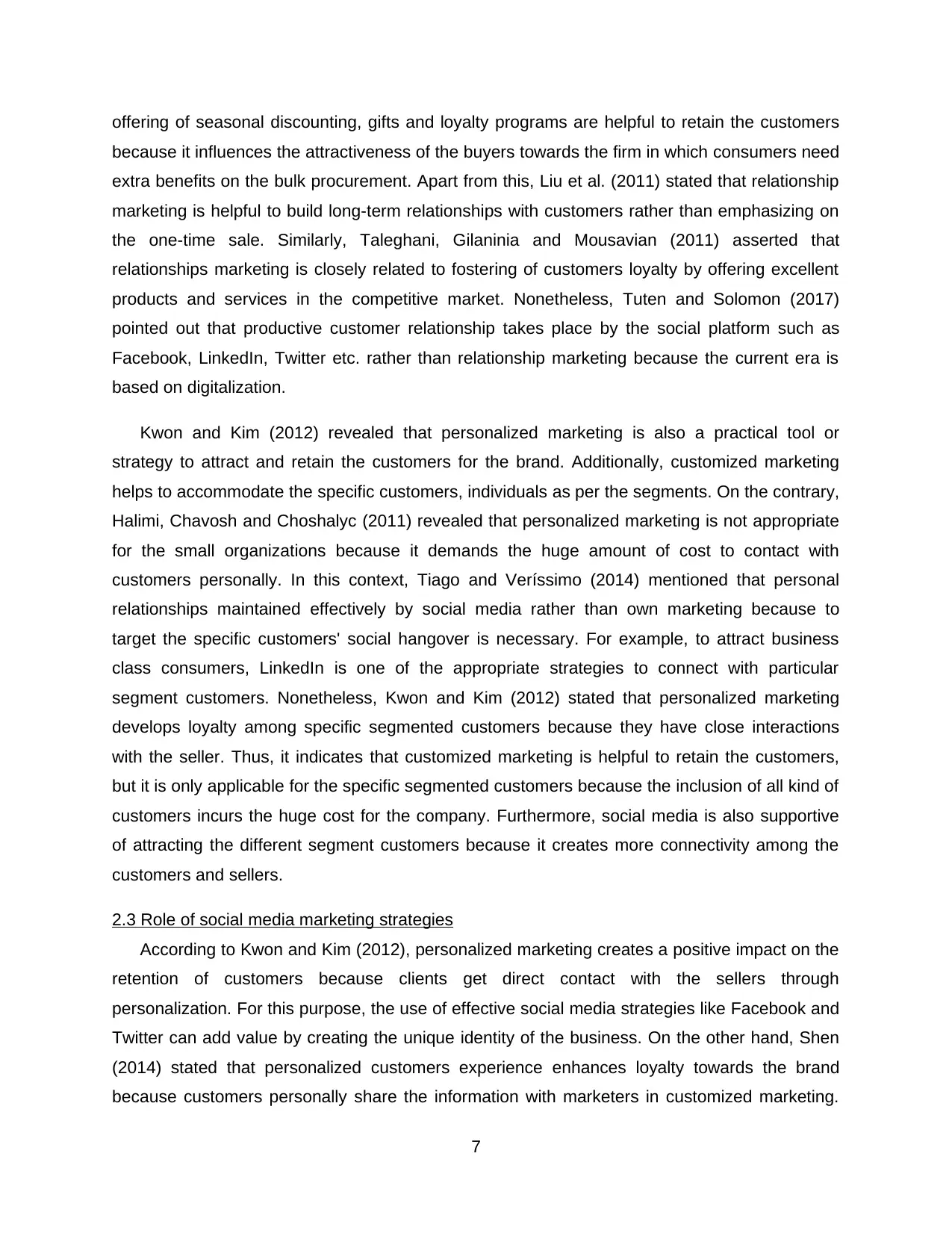
offering of seasonal discounting, gifts and loyalty programs are helpful to retain the customers
because it influences the attractiveness of the buyers towards the firm in which consumers need
extra benefits on the bulk procurement. Apart from this, Liu et al. (2011) stated that relationship
marketing is helpful to build long-term relationships with customers rather than emphasizing on
the one-time sale. Similarly, Taleghani, Gilaninia and Mousavian (2011) asserted that
relationships marketing is closely related to fostering of customers loyalty by offering excellent
products and services in the competitive market. Nonetheless, Tuten and Solomon (2017)
pointed out that productive customer relationship takes place by the social platform such as
Facebook, LinkedIn, Twitter etc. rather than relationship marketing because the current era is
based on digitalization.
Kwon and Kim (2012) revealed that personalized marketing is also a practical tool or
strategy to attract and retain the customers for the brand. Additionally, customized marketing
helps to accommodate the specific customers, individuals as per the segments. On the contrary,
Halimi, Chavosh and Choshalyc (2011) revealed that personalized marketing is not appropriate
for the small organizations because it demands the huge amount of cost to contact with
customers personally. In this context, Tiago and Veríssimo (2014) mentioned that personal
relationships maintained effectively by social media rather than own marketing because to
target the specific customers' social hangover is necessary. For example, to attract business
class consumers, LinkedIn is one of the appropriate strategies to connect with particular
segment customers. Nonetheless, Kwon and Kim (2012) stated that personalized marketing
develops loyalty among specific segmented customers because they have close interactions
with the seller. Thus, it indicates that customized marketing is helpful to retain the customers,
but it is only applicable for the specific segmented customers because the inclusion of all kind of
customers incurs the huge cost for the company. Furthermore, social media is also supportive
of attracting the different segment customers because it creates more connectivity among the
customers and sellers.
2.3 Role of social media marketing strategies
According to Kwon and Kim (2012), personalized marketing creates a positive impact on the
retention of customers because clients get direct contact with the sellers through
personalization. For this purpose, the use of effective social media strategies like Facebook and
Twitter can add value by creating the unique identity of the business. On the other hand, Shen
(2014) stated that personalized customers experience enhances loyalty towards the brand
because customers personally share the information with marketers in customized marketing.
7
because it influences the attractiveness of the buyers towards the firm in which consumers need
extra benefits on the bulk procurement. Apart from this, Liu et al. (2011) stated that relationship
marketing is helpful to build long-term relationships with customers rather than emphasizing on
the one-time sale. Similarly, Taleghani, Gilaninia and Mousavian (2011) asserted that
relationships marketing is closely related to fostering of customers loyalty by offering excellent
products and services in the competitive market. Nonetheless, Tuten and Solomon (2017)
pointed out that productive customer relationship takes place by the social platform such as
Facebook, LinkedIn, Twitter etc. rather than relationship marketing because the current era is
based on digitalization.
Kwon and Kim (2012) revealed that personalized marketing is also a practical tool or
strategy to attract and retain the customers for the brand. Additionally, customized marketing
helps to accommodate the specific customers, individuals as per the segments. On the contrary,
Halimi, Chavosh and Choshalyc (2011) revealed that personalized marketing is not appropriate
for the small organizations because it demands the huge amount of cost to contact with
customers personally. In this context, Tiago and Veríssimo (2014) mentioned that personal
relationships maintained effectively by social media rather than own marketing because to
target the specific customers' social hangover is necessary. For example, to attract business
class consumers, LinkedIn is one of the appropriate strategies to connect with particular
segment customers. Nonetheless, Kwon and Kim (2012) stated that personalized marketing
develops loyalty among specific segmented customers because they have close interactions
with the seller. Thus, it indicates that customized marketing is helpful to retain the customers,
but it is only applicable for the specific segmented customers because the inclusion of all kind of
customers incurs the huge cost for the company. Furthermore, social media is also supportive
of attracting the different segment customers because it creates more connectivity among the
customers and sellers.
2.3 Role of social media marketing strategies
According to Kwon and Kim (2012), personalized marketing creates a positive impact on the
retention of customers because clients get direct contact with the sellers through
personalization. For this purpose, the use of effective social media strategies like Facebook and
Twitter can add value by creating the unique identity of the business. On the other hand, Shen
(2014) stated that personalized customers experience enhances loyalty towards the brand
because customers personally share the information with marketers in customized marketing.
7
⊘ This is a preview!⊘
Do you want full access?
Subscribe today to unlock all pages.

Trusted by 1+ million students worldwide
1 out of 28
Related Documents
Your All-in-One AI-Powered Toolkit for Academic Success.
+13062052269
info@desklib.com
Available 24*7 on WhatsApp / Email
![[object Object]](/_next/static/media/star-bottom.7253800d.svg)
Unlock your academic potential
Copyright © 2020–2025 A2Z Services. All Rights Reserved. Developed and managed by ZUCOL.





